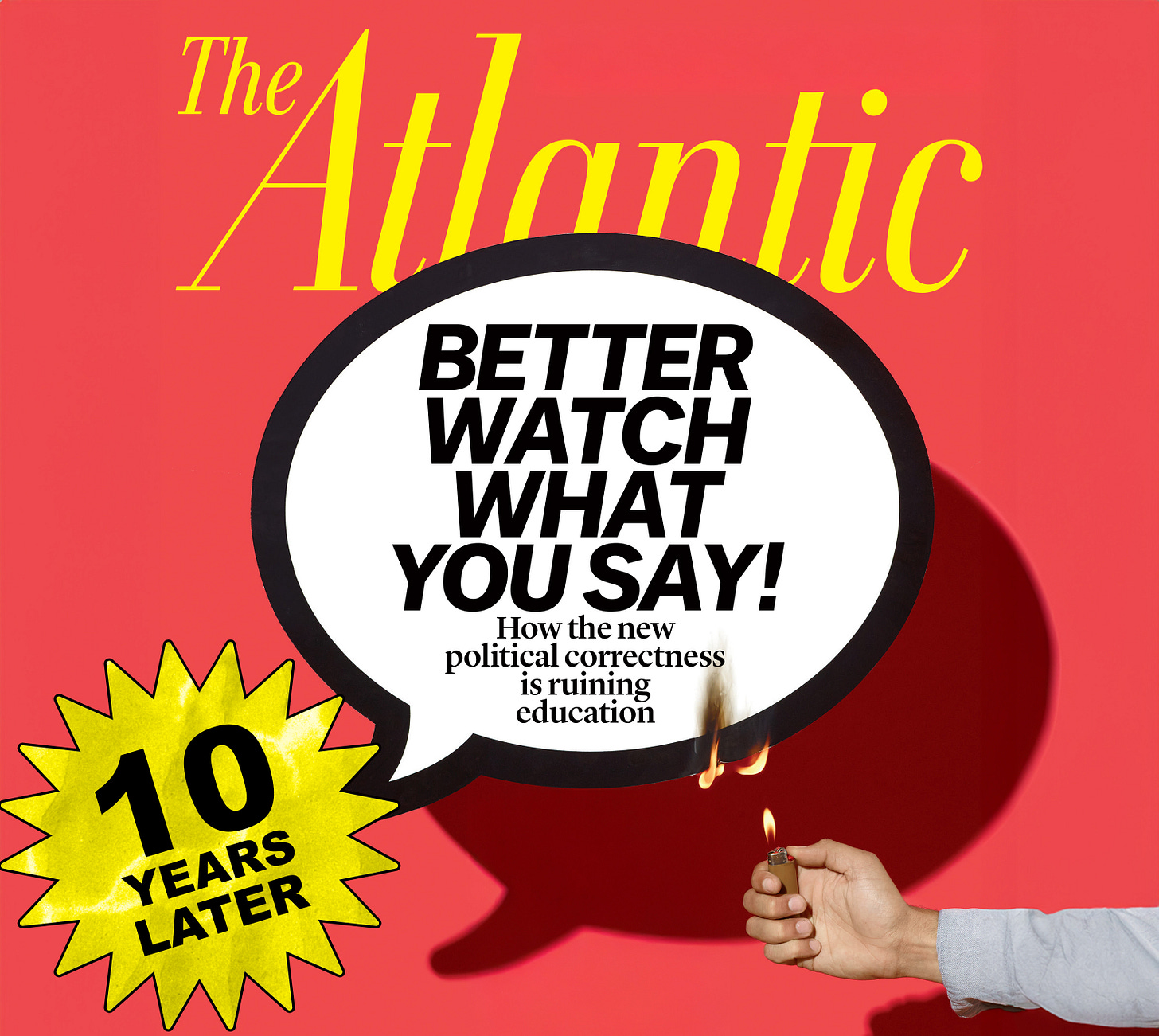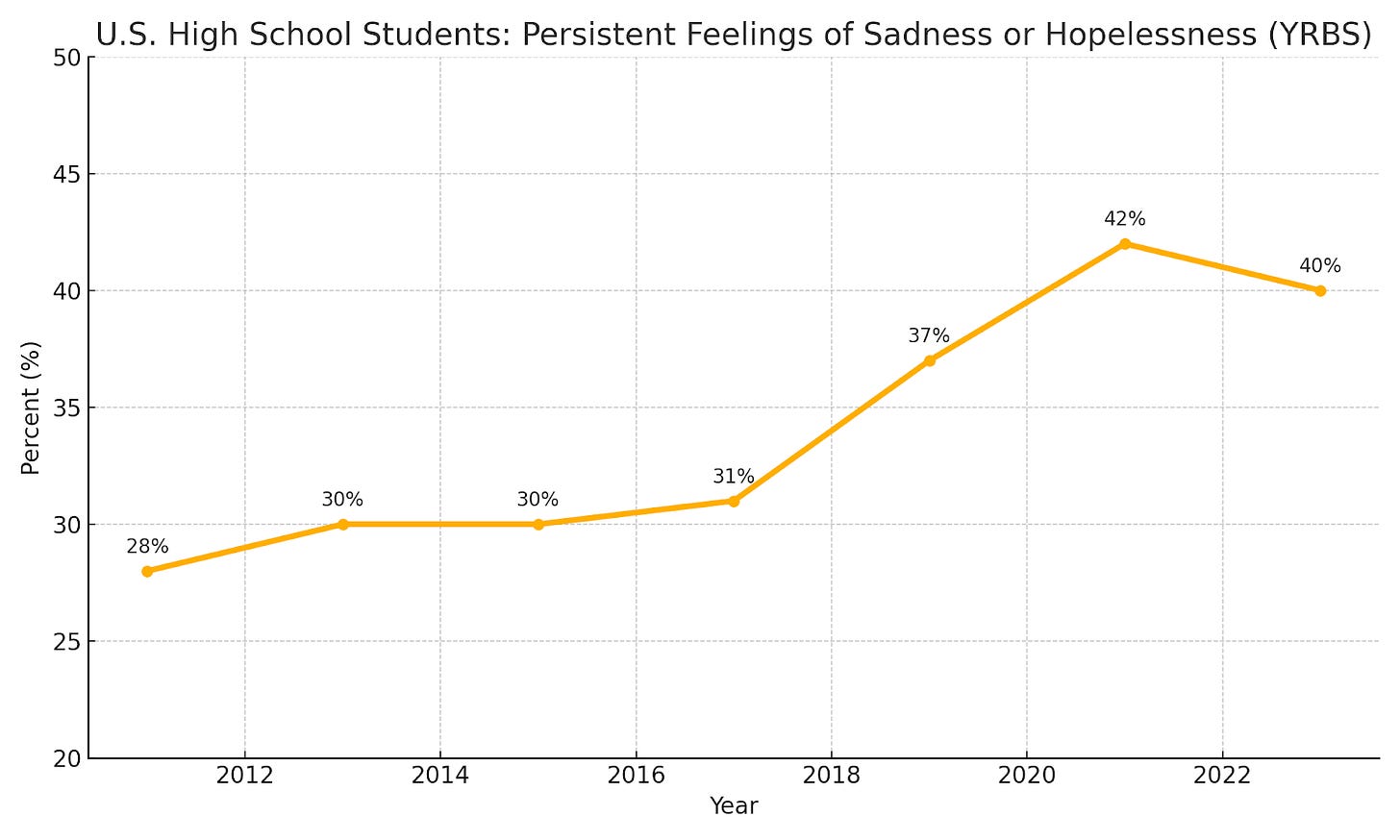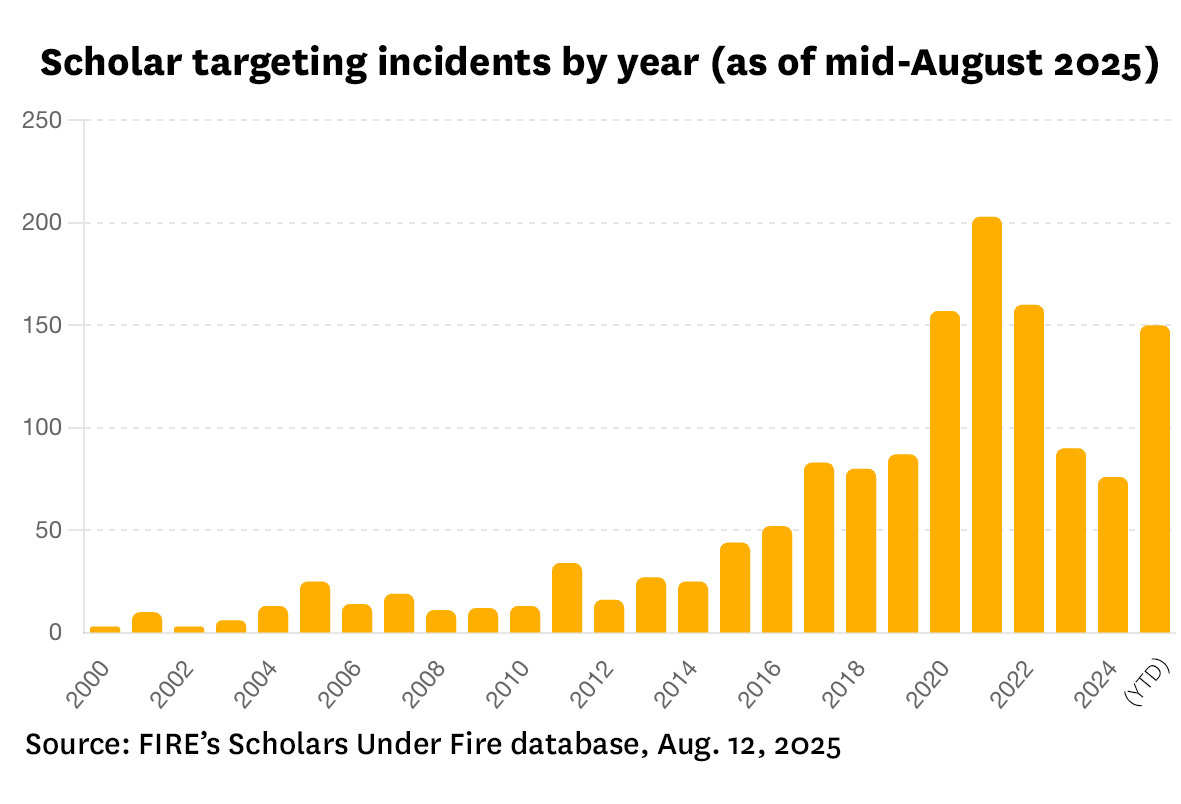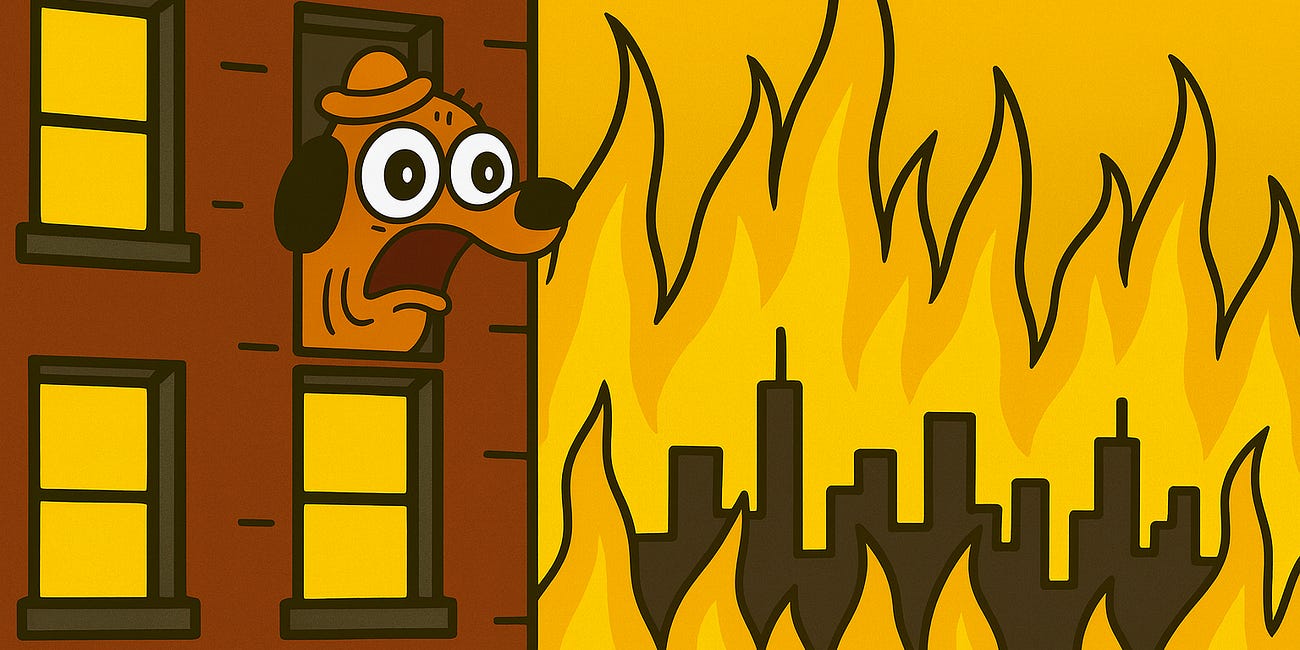Ten years after ‘The Coddling of the American Mind’: What we warned, what happened, and what’s still at stake
Guess how teaching kids the habits of anxious and depressed people turned out?
The last few weeks have been absolutely insane, and if you’ve been keeping up with my work here on ERI and our work at FIRE — or if you’ve just…you know…been alive — lately, you know why I’m saying that.
It started, obviously, with the horrifying political assassination of Charlie Kirk on campus, in front of a crowd of thousands in person and millions more on social media. It continued with the unfortunately all-too-predictable Cancel Culture campaign, with countless people across a variety of private businesses and industries being investigated, threatened, or losing their jobs for protected speech surrounding Kirk’s death.
It was worsened by government officials, including the vice president, who enthusiastically cheered this behavior on and engaged in it themselves. We have senators calling for the firing of college professors over their comments on the Kirk assassination. We have the FCC openly calling for censorship of comedy. And we have the Attorney General promising to pursue what the administration considers to be “hate speech.”
It’s nuts, especially considering how many of these people claimed in the recent past to be ardent defenders of free speech. As I wrote in my recent New York Times op-ed, however, this kind of whiplash is unsurprising. When you defend free speech on principle, you have to expect to be disappointed.
All that mayhem nearly caused me to forget that it’s been ten years this month since Jon Haidt and I published “The Coddling of the American Mind” in The Atlantic, a piece that pointed to a serious problem in higher education. The piece was published online in August of 2015 but actually became the cover story for the September 2015 issue, and was surprisingly well received (at least at first).
In light of that milestone, I wanted to offer some thoughts about the article, the data, the current landscape, and where we can go from here.
What we warned about in ‘Coddling,’ and what ended up happening
As you may remember, our article argued that American campuses had embraced a culture of “vindictive protectiveness” — one designed to insulate some students from discomfort, shield them from disfavored words and ideas, and punish those who caused offense, whether intentionally or unintentionally. The trouble was not just that such rules restrict debate, but that they modeled and rewarded patterns of thought that psychologists have long identified as drivers of anxiety and depression.
More than that, we warned that teaching this way of thinking was going to be a disaster for mental health, academic freedom, and free speech, and that it would almost certainly provoke a right-wing backlash.
Sadly, over the last decade, all of those things happened.
Our piece garnered a lot of attention, as we expected, but our actual argument was often either misconstrued or flat out misrepresented. For example, critics accused us of calling students “snowflakes,” a term Jon and I both criticized because our claim was actually the opposite: children are not fragile, they are antifragile. We were telling people that we grow stronger by facing challenges, so we harm children when we overprotect them.
Another point we made was that the problem lay not in the students, but in the adults who taught them to believe they are fragile. Universities and other institutions were reinforcing psychologically harmful ways of thinking — what cognitive behavioral therapists call “cognitive distortions.” These include catastrophizing, which means treating setbacks or disagreements as disasters; black and white thinking, or sorting people into heroes and villains, allies and enemies; and overgeneralizing, which means drawing sweeping, exaggerated conclusions from limited evidence.
The mental health consequences of social justice fundamentalism
In their 2015 article and 2018 book, “The Coddling of the American Mind,” Greg and Jonathan Haidt argue that cognitive distortions (practices like catastrophizing, black and white thinking, overgeneralizing, discounting positives, and emotional reasoning) and overprotecting children results in an external
Now, it’s important to pause here and clarify that we never argued that the cause of the problem is students learning these distorted ways of thinking in higher ed. In fact, we acknowledged in the original article that students were actually arriving on campus with these distorted ways of thinking already programmed in, and that higher ed encouraged it.
However, that may lead some to conclude that the problem is therefore not the fault of higher education. I personally disagree. The reality is that a lot of the ideology that is baked into K-12 education came from the bad ideas being promulgated in education schools going back many decades, and were fully fleshed out in the “first great age of political correctness” — roughly 1985-1995, as Rikki Schlott and I discussed in our book The Canceling of the American Mind.
I also know from experience as a parent that this stuff is internalized and promoted by parents before it is inculcated into our young people. And where did the parents get it? Higher ed — especially elite (or elite-ish) higher ed. That’s where they were introduced to the social justice fundamentalism that leads to these catastrophizing, distorted ways of thinking, and that’s why I think the problem has largely — though of course not exclusively — come out of higher ed. It just happened over a longer time horizon.
Making matters worse was that schools assumed promoting this distorted thinking would encourage students to achieve positive political ends. This was a cruel and foolish calculation — cruel, because it made the students anxious and depressed; foolish, because anxious and depressed people generally do not make very effective activists. Activism separated from hope or agency leads to destructive lashing out, and we have seen a great deal of precisely that in the last decade.
Within months of our article, Yale erupted in protests over an email from Erika Christakis suggesting students might handle Halloween costumes without administrative guidance. Students surrounded and screamed at her husband Nicholas, demanding apologies for the “harm” of his wife’s call to respect students’ autonomy.
In 2017, rioters caused over half a million dollars of damage and assaulted people while shutting down a speech by provocateur Milo Yiannopoulos at Berkeley. Their reasoning (or at least their stated justification) was perfectly in line with the distorted thinking they were being encouraged to accept: Milo’s speech might cause psychic harm; psychic harm has physical effects, which makes it violence; and therefore, physical violence was justified to stop him from speaking.
By 2023 and 2024, shout-downs reached record highs, almost always led by pro-Palestinian students. Speakers labeled “Zionist” were routinely silenced, sometimes just for being Jewish professors. This was social justice fundamentalism in its purest form: reducing individuals to caricatures based on race, gender, sexuality, or politics, and then punishing them for the category they were assigned.
And as expected, mental health trends have continued to worsen. CDC data shows levels of persistent sadness, suicidal thoughts and behaviors, and poor mental health rose dramatically through 2021, especially for girls and LGBTQ+ youth. The newest data (from 2023) shows slight improvements from 2021’s nadir — persistent sadness fell from 42% to 40% overall and from 57% to 53% among girls, for example — but rates remain historically high. Studies also show that female liberals are getting more depressed, faster. In an annual survey that asked high school seniors to rate how much they agreed with statements like “I feel that my life is not very useful” and “sometimes I think I am no good at all,” those feelings dramatically increased for liberal students in general, and girls in particular, starting in 2012.
FIRE found the same trend in its 2026 College Free Speech Rankings poll: just over a quarter of very conservative males reported experiencing depressive symptoms at least half of the time — a concerning number to be sure. But for very liberal women, nearly half of them were depressed at least half of the time.
We also warned that the rising illiberal trends on campus would affect free speech and academic freedom, and the last ten years have also borne this out. Speech policing on campus became more widespread in the second half of the 2010s, with the number of scholars targeted for their research or speech rising from over 40 in 2015 to over 200 in 2021, according to FIRE’s Scholars Under Fire database. In the summer of 2020, during nationwide outrage over the murder of George Floyd, FIRE’s caseload spiked to five times what it normally would have been.
That surge came with petitions to punish, campaigns to fire, and a growing taste for Cancel Culture. As a result, people felt far less free to speak their minds. FIRE’s surveys show a rising trend of self-censorship on college campuses. In 2021, our survey research found that more than four in five students reported self-censoring at least sometimes — evidence of a chilling environment even apart from formal discipline. Campus surveys since then have confirmed students’ fear of speaking on divisive topics. The 2026 College Free Speech Rankings (based on nearly 70,000 students across 257 campuses, fielded Jan.-June 2025) reported dramatic difficulty discussing the Israel-Palestine conflict (53% found it hard), with broader indicators of self-censorship and sanctioning attitudes mapping onto the very dynamics we outlined a decade ago.
This is what a chilled speech climate looks like, and it’s no wonder that the political backlash we warned about — and are currently seeing — also came to pass.
As we feared, one form of censorship has provoked another.
The political backlash has now reached a fever pitch
The left-driven Cancel Culture that began in 2014, blew up in 2017, and surged even more after George Floyd’s murder was monumental. I have written about and discussed it at length — including in my and Rikki’s book The Canceling of the American Mind.
What we’re seeing now, however, is something else entirely.
Yes, there has absolutely been a rise in right-driven Cancel Culture more recently — particularly after the attempt on then-candidate Donald Trump’s life last year, and again in the wake of Charlie Kirk’s assassination earlier this month. As I mentioned above, a lot of people have been threatened, investigated, and fired for their speech regarding Kirk’s death. There is even a website that aggregates accusations of insensitive or incendiary comments about Kirk (which I won’t share because it needs no more oxygen) designed to help people to be doxxed and canceled.
This behavior received the encouragement of the current White House, which is alarming enough. But it’s the government’s own behavior that’s really terrifying.
See, Cancel Culture is about the creation of mobs, and the Trump administration has clearly facilitated and celebrated that. But when you have government officials like Pam Bondi threatening to “target” people for “hate speech” (which she tried to walk back after criticism) and President Trump doubles down on it; or when you have FCC Chairman Brendan Carr jawboning ABC and Disney with the FCC’s regulatory authority unless they “take action” on Jimmy Kimmel (which ABC did by pulling him off the air, to much criticism, before bringing him back on last week); or when Deputy Attorney General Todd Blanche defends the idea of using of RICO statutes to go after protestors; that’s not Cancel Culture. It’s actually something much worse: the clear and naked use of political power to engage in authoritarian-style censorship.
Thankfully, many on the right rejected the invitation to indulge in this madness. Senator Ted Cruz, for example, rightly warned that the left will inevitably deploy any weapons the right devises the moment they regain power. As I myself put it in my New York Times op-ed, I don’t enjoy invoking the “self-interest” argument for free speech because the principle is and should be enough — but it is still important to remember that the weapon you wield today will be used against you tomorrow.
Too many on the campus left did not heed that lesson, and we’re seeing the consequences playing out right now. We definitely do not want this constant tribal tit-for-tat to go on. FIRE’s and my entire project is getting people off of this seesaw of censorial behavior once and for all. That’s the only way to preserve free speech as a principle, and to prevent things from getting worse than they already are.
Where we go from here
Despite the success of the 2015 article and the subsequent book Jon and I co-authored, also titled The Coddling of the American Mind, I am frustrated that more people still haven’t gotten the point: We need to stop teaching young people the mental habits of anxious and depressed people. Whether it is meant to protect them or to prod them into taking what advocates see as pro-social action, these methods and tactics have clearly backfired.
Until we address the fundamental mistake of teaching our young people these catastrophic ways of thinking, the trends we’re seeing are likely to continue. Our already distrusted K-through-Ph.D. institutions will continue to lose the confidence of the public, and who can blame them? It has been and continues to be a system that promotes distorted thinking, promotes illiberal attitudes about free speech, and further polarizes us — producing an educated elite class that is very much at odds with the rest of American society.
There are a lot of potential solutions to this, however, and I intend to dig deeply into them in a future post.
SHOT FOR THE ROAD
Since we’re already in the time machine, I thought it’d be good to share this video of Jonathan Haidt and me — when I was less gray but more fat — discussing why we hate the term “snowflake,” among other things.








A few words about the Biden Admin's systematic pressure campaign on social media and other platforms to censor wrongthink, particularly about COVID, would have bolstered the otherwise mostly balanced take of this piece. It's not as though the Trump Admin invented the recent history of censorial governmental actions -- they were/are just more open about it. An argument can be made that it's an improvement over subterfuge.
Minor correction, they didn’t call for censorship of comedy, they called for censorship of Jimmy Kimmel. 😁